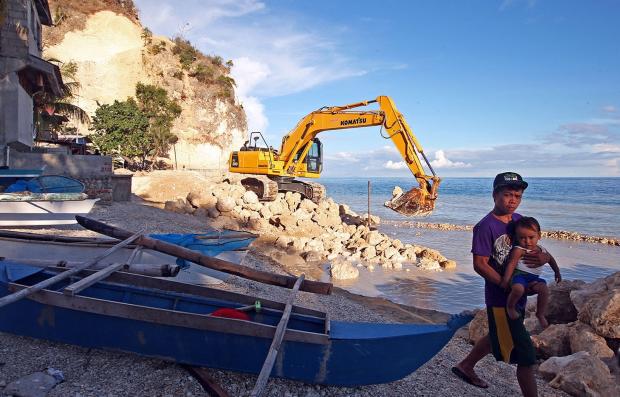Reclamation work on Boljoon seashore ‘not authorized’

Fishermen of sitio Talisay, Poblacion in Boljoon worry about their livelihood after limestone boulders and debris from a DPWH project are dumped on the seashore. Part of the beach is being reclaimed but residents wonder what it is for. (CDN PHOTO/ TONEE DESPOJO)
Why is a “reclamation” project going on in the seashore of Boljoon town, and who authorized it?
Why dumped into the seashore, boulders and limestone debris from Ili Rock, the mountain where a P42 million excavation is underway by the Department of Public Works and Highways (DPWH), which considered it as an anti-landslide measure?
These questions will be taken up in a meeting this week called by the Department of Environment and Natural Resources (DENR) 7.
The DENR earlier exempted the coastal project from the requirement of an Environmental Certificate of Compliance (ECC) when the agency issued a Certificate of Non-Coverage on Sept. 16, 2014 signed by Engr. William P. Cuñado as OIC regional director.
“We will schedule a technical conference for QM Builders and DPWH this week to let them answer allegations like indiscriminate dumping of waste materials,” said DENR 7 spokesman Eddie Llamedo yesterday.
A site investigation was already made by the Environmental Management Bureau (EMB) 7 after receiving complaints from fisherfolk two weeks ago.
Cuñado told Cebu Daily News yesterday the Certificate of Non-Coverage he issued only covers the “slope benching” work on Ili Rock and not a reclamation project in the sea below.
“All reclamation projects, no matter how small, requires an ECC. Just because a project is funded by the calamity fund does not mean it is exempt from that requirement,” he said.
The certificate means the project would have no adverse impact on the environment, and does not need an ECC.
When Cebu Daily News visited Boljoon town on Monday, fishermen complained that the dumping of limestone rocks has left the seawater murky, and that boulders blocked the access of their fishing boats to the shore.
The fishermen were informed that the “reclamation” project would turn the beach into a park. Several families were asked to relocate to another site.
The loss of livelihood and defacing of Ili Rock, the town’s most famous natural landmark, prompted the Boljoon municipal council to pass a resolution on Nov. 17 urging the DPWH to immediately stop excavating till a public hearing is held.
On paper, the project is called “widening of critical/landslide section along Natalio Bacalso Avenue, Bojoon, Cebu”.
Another DPWH project for P43.9 million in Boljoon is identified as “rehabilitation/reconstruction of shore protection structures at Poblacion, Boljoon, Cebu”. Both are financed by calamity funds released by the national government after the Bohol-Cebu earthquake in Oct. 15, 2013, which caused a landslide below Ili Rock.
“Technically, there are no violations since they did not apply for an ECC,” said Llamedo but the contractor has to answer for any dumping of waste materials into the sea.
Asked why the CNC was issued in the first place, Llamedo said the project size fell within the “threshold” of coverage, which is less than two kilometers.
The space allocation stated in the DPWH project was only 180 meters.
The Certificate of Non-Coverage is given to “infrastructure projects, minor roads and bridges, new construction or widening of roads” less than two kilometers that are not environmentally critical projects.
¨If they decide to expand and the length exceeds the threshold, then that is the time they will need to secure an ECC,¨ said Llamedo.
He said that QM builders may be held accountable for storage and disposal of extracted materials. This could be a be a violation of Republic Act 9003 or the Ecological Solid Waste Management Act of 2000.
And because of Ili Rock’s value as a “heritage site” officially listed in a 2011 Boljoon ordinance on Heritage Properties, there could be a violation of Presidential Decree No. 1586 or the Environmental Impact Statement System which requires all projects to have an ECC.
The EIS protects areas of ‘”unique historical, archeological, geological or scientific interests.¨
Llamedo said that aside from discussing investigation findings, the DENR 7 will also ask for a commitment from the contractor and DPWH to properly manage waste, as well as detailed plans on slope stabilization and waste disposal.
”We can just help fast track the processing of the ECC. If (there is dumping of waste to the sea) there must be a violation that was made,” Cuñado said in a separate interview.
He said the field findings of the EMB team that went to Boljoon last week raised matters that need to be clarified by the parties.
“There are matters ‘for discussion’ that was noted so I called for a technical conference,” Cuñado said.
Dumping of waste in the sea, he said, is not a contiguous project and requires an ECC permit from DENR.
Related Stories:
DPWH won’t stop Boljoon projects; loss of heritage site deplored
Boljoon’s ‘Ili Rock’ Vanishing
Disclaimer: The comments uploaded on this site do not necessarily represent or reflect the views of management and owner of Cebudailynews. We reserve the right to exclude comments that we deem to be inconsistent with our editorial standards.
